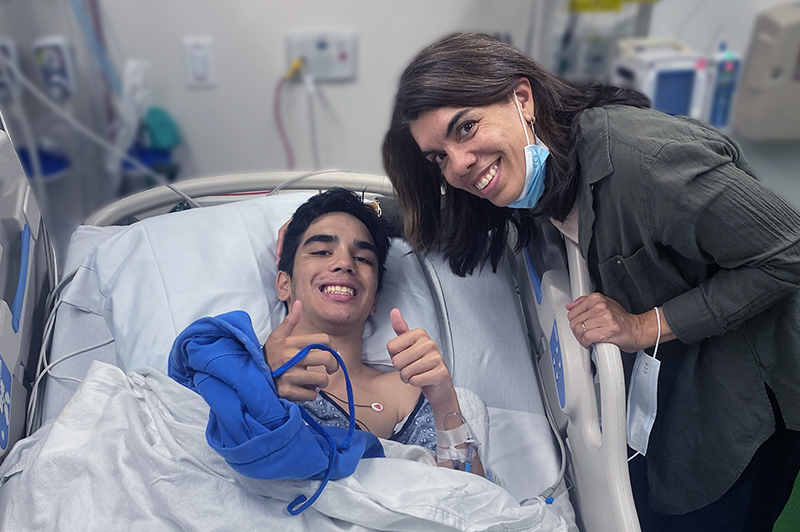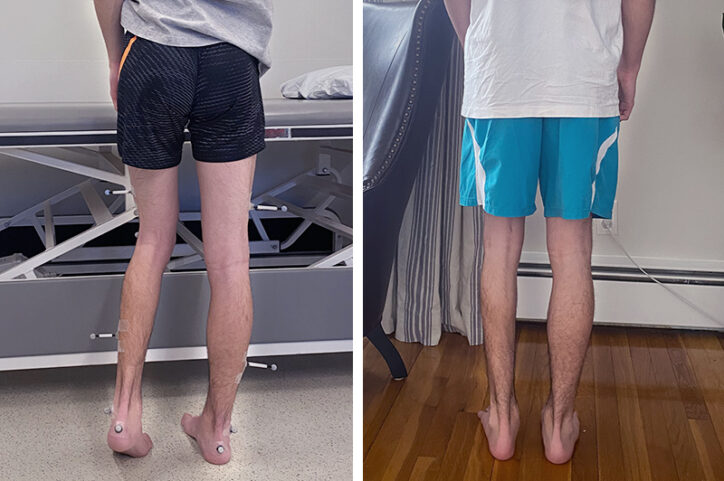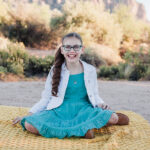Lacrosse, cerebral palsy, and leadership: Luke’s story

When he returned to lacrosse after surgery on his left leg, Luke Kilfoyle wasn’t nervous. In the five and a half months since his surgery, he’d worn a cast, gone to school in a wheelchair, used a walker, then a cane and ankle-foot orthosis (AFO). He’d spent hours in physical therapy and the gym. By the time he returned to the field, Luke’s leg was strong, and he was ready.
“I wasn’t nervous because if I could play with a ‘bad leg,’ I knew I’d be able to play way easier now,” he says.
Cerebral palsy (CP) had never prevented Luke from being athletic. He played T-ball when he was 6 and quickly graduated to lacrosse and golf. But a significant growth spurt during the COVID-19 pandemic presented a new set of challenges.
Cerebral palsy and growth during the pandemic
Luke was in seventh grade when the pandemic brought school sports to a screeching halt in 2020. Like nearly every player he knew, the loss of structured training turned into months of inactivity. The timing was particularly bad for 13-year-old Luke, who grew 2½ inches that year. He and his parents would later learn that his left femur had grown inward rather than straight, a condition known as femoral anteversion.
“I always knew puberty would be challenging,” says his mother, Candice. “By the end of that year, his left knee was pointing entirely to the right, and he couldn’t put his foot on the ground, so he was walking on his toes.”

When Luke returned to sports in eighth grade, he found himself struggling to do things that once came easily. “I couldn’t move the way I wanted to move,” he recalls. “I was slower, and my muscles were much tighter.”
By his first year in high school, his mobility issues had grown worse. He noticed himself getting tired easily and feeling off balance. He got cut from the golf team because of the way his leg affected his stance. “I wasn’t the person I’d been when I could compete at the highest level.”
Seeking care, getting answers
Dr. David Fogelman of Boston Children’s Cerebral Palsy and Spasticity Center (Luke’s physician since he was 8) introduced Luke and Candice to orthopedic surgeon, Dr. Benjamin Shore.
After a CT scan provided a three-dimensional image of Luke’s thighbone and a gait analysis showed the effects on his walking stride, Dr. Shore asked Luke if the angle of his leg bothered him. It did. He asked Luke about his treatment goals. “My main goals were to be able to put my heel on the ground and to run and walk better.”
Then Luke had some questions of his own: What would surgery involve? Dr. Shore described a procedure called femoral derotational osteotomy that would involve cutting and repositioning Luke’s thighbone. Would he be able to walk and run like he had before? After months of recovery, he would.

If Luke chose to have surgery, it was a good time to do so. He would grow more, but not as abruptly as he had in seventh grade. He, his parents, and Dr. Shore would monitor his growth throughout his teen years. They would manage any spasticity he experienced with Botox, daily stretching, and, when needed, physical therapy to ensure his leg remained straight.
Tending goal and taking charge
For several months after his surgery in August, Luke couldn’t put any weight on his leg at all. In October, his bone had healed enough for him to walk with the support of a cane and AFO. Finally, in late December, Dr. Shore cleared him for full weight bearing. “I was really excited,” says Luke. “Now I had to work as hard as possible to make sure I’d be back for lacrosse season.”
Throughout the winter, he focused on strengthening his leg and retraining his gait. At the end of January, he joined his team for off-season lacrosse training. When the season started for real in late March, he was back in position, guarding the net from opponents’ attacks. “I can move laterally and quickly,” he says. “I can make so many more saves now, it’s unbelievable.”

His job on the lacrosse field may be to block other players’ shots, but Luke has an unobstructed view of his own goals. “I want to make sure I give myself the opportunity to be the best version of myself. That means treating my body with respect.”
For their part, Luke’s parents are proud of their son’s leadership. “The more we’ve learned about CP, the more Luke has taken charge,” says Candice. “His doctors at Boston Children’s support that. They answer our questions and listen to our concerns, but they really want Luke to be leading his care.”
Learn more about the Cerebral Palsy and Spasticity Center and Orthopedic Center.
Related Posts :
-

A cerebral palsy journey lands in Boston: Ashlyn’s hip surgery
Eleven-year-old Ashlyn’s parents describe her as spicy, strong willed, and determined. Those qualities have served her well through a ...
-

'Anything is possible': The sky’s the limit for teen with cerebral palsy
Jack Goldberg is on a mission. “I want other kids to see that if you work hard and put your ...
-

Research offers guidance on genetic testing for cerebral palsy
A recent meta-analysis confirms what a small study at Boston Children’s found last year: About 1 in 4 children with cerebral ...
-

What it’s like to have SDR surgery: Scarlet’s story
Scarlet is 9 years old. When she was 7, she underwent selective dorsal rhizotomy (SDR), a procedure in which a surgeon cuts ...





